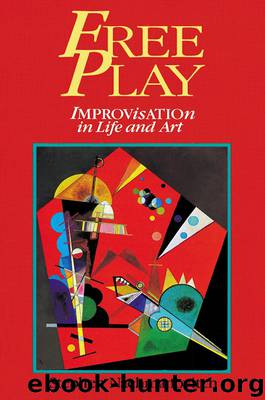Free Play: Improvisation in Life and Art by Stephen Nachmanovitch

Author:Stephen Nachmanovitch [Nachmanovitch, Stephen]
Language: eng
Format: epub
Tags: Creativity, Happiness, Inspirational, Motivational, Non-Fiction, Personal Growth, Self-Help
ISBN: 9781440673085
Google: 7Vmcy7yMFKIC
Amazon: 0874776317
Publisher: Penguin
Published: 1991-04-30T23:00:00+00:00
Shaping the Whole
In free improvisation we play the sounds and silences, and as we play them they disappear forever. In producing large works—books, symphonies, plays, research projects, films—we are perforce taking the results of many inspirations and melding them together into a flowing structure that has its own integrity and endures through time. The most ephemeral thoughts and feelings are gradually shaped into hard copy that is worked over, painted over, edited, and refined before the public sees it. This is where the sculptor cuts away and polishes the stone; where the painter covers the beginnings of the image with layer upon layer of enriching re-vision.
The muse presents raw bursts of inspiration, flashes, and improvisatory moments in which the art just flows out. But she also presents the technical, organizational job of taking what we have generated, then filing and fitting and playing with the pieces until they line up. We arrange them, cook them, render them down, digest them. We add, subtract, reframe, shift, break apart, melt together. The play of revision and editing transforms the raw into the cooked. This is a whole art unto itself, of vision and revision, playing again with the half-baked products of our prior play.
It is essential to perform that secretarial labor in a way that is not mechanical. Editing must come from the same inspired joy and abandon as free improvisation. Stravinsky tells us, “The idea of work to be done is for me so closely bound up with the idea of the arranging of materials and of the pleasure that the actual doing of the work affords us that, should the impossible happen and my work suddenly be given to me in a perfectly completed form, I should be embarrassed and nonplussed by it, as by a hoax.”33
There is a stereotyped belief that the muse in us acts from inspiration, while the editor in us acts from reason and judgment. But if we leave our imp or improviser out of the process, re-vision becomes impossible. If I see the paragraph I wrote last month as mere words on a page, they become dead and so do I. But if I look at them sideways, do a little disappearing, they begin to slither and grow tentacles like primitive living things; the tentacles begin to link up with each other, to hook and unhook, until a pattern appears and clarifies itself.
The evolving organism takes on a momentum and identity of its own. We conduct a dialogue with the living work in progress. We need not be shy about talking out loud to our work. Generally we regard talking to oneself out loud as a sign of lunacy, and answering oneself back a sign of even worse lunacy; but in the case of creative bafflement this is a very valuable technique. Just get away from other people for a while so you can do it undisturbed. At crucial times this inner dialogue becomes the core of the creative process.
Some elements of artistic editing: (1)
Download
This site does not store any files on its server. We only index and link to content provided by other sites. Please contact the content providers to delete copyright contents if any and email us, we'll remove relevant links or contents immediately.
Rewire Your Anxious Brain by Catherine M. Pittman(17599)
Talking to Strangers by Malcolm Gladwell(11905)
The Art of Thinking Clearly by Rolf Dobelli(8862)
Mindhunter: Inside the FBI's Elite Serial Crime Unit by John E. Douglas & Mark Olshaker(7848)
Becoming Supernatural by Dr. Joe Dispenza(7117)
Change Your Questions, Change Your Life by Marilee Adams(6654)
The Road Less Traveled by M. Scott Peck(6646)
Nudge - Improving Decisions about Health, Wealth, and Happiness by Thaler Sunstein(6642)
The Lost Art of Listening by Michael P. Nichols(6481)
Enlightenment Now: The Case for Reason, Science, Humanism, and Progress by Steven Pinker(6414)
Win Bigly by Scott Adams(6327)
Mastermind: How to Think Like Sherlock Holmes by Maria Konnikova(6250)
The Way of Zen by Alan W. Watts(5809)
Daring Greatly by Brene Brown(5650)
Grit by Angela Duckworth(4746)
Big Magic: Creative Living Beyond Fear by Elizabeth Gilbert(4734)
Men In Love by Nancy Friday(4339)
Flow by Mihaly Csikszentmihalyi(4060)
The Four Tendencies by Gretchen Rubin(4028)
